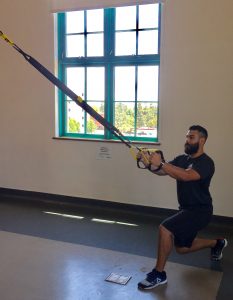Suspension straps provide a great modification to lunges for the beginner or someone rehabbing. Even though lunges are a tried and true exercise for personal trainers and fitness fanatics, not everyone can start with them.
In my quest to find the best practices of modifying lunges for clients, I discovered that many of the 50 trainers I spoke to were using suspension straps for static lunges. The reason being that suspension straps allow clients to minimize their ROM and degree of balance difficulty.
Sometimes clients are under the impression that they must absolutely avoid a particular movement or series of movements altogether when they are rehabbing or feel any discomfort. One reason for this is that they fear further injury. Another reason is an old school approach to recovery.
What ever the case may be, you can counteract gravity by using a suspension strap, like this:
Immobilize. Stat!
It was previously thought that clients with injuries should immobilize completely. That notion has been found to cause muscular atrophy and joint immobility over time. What is more realistic in terms of maintaining strength and range of motion (ROM) is to provide clients with regressions and support to do the exercises that will enhance their activities of daily living.

Familiarize your clients with the strap by using a squat
Before progressing to the lunge, also known as the split stance squat among other names, trainers can begin by having clients do a traditional squat holding the suspension straps. This will allow them to build the confidence of their balance control and ROM. Once the client is ready, progress them to the first variation of a lunge with the suspension strap.
How to do Suspension Strap Lunges Step by Step
- Face the anchor point and center the front leg.
- Hold the straps so they are taut and stack the elbows under the shoulders.
- Bend the back leg lowering the hips to a 90 degree bend.
- To return to starting position, drive through the heel while extending the hips.
- Keep the spine straight and the chest lifted.
[info type=”facebook”]Do you have a useful way to get clients to build their confidence and strength of doing lunges with suspension straps?If you’re an NFPT trainer, join the Facebook Community Group to share and if you’re not, come chat with NFPT here![/info].
Theresa Perales has an MA in Spanish, and is an ESL teacher at San Diego State University (SDSU). After years of struggling with her weight, she decided to give exercise a try. A passion for health and fitness grew instantly and inspired her to become certified as a personal trainer with NFPT, and as a group fitness instructor with AFAA Group Fitness and Madd Dog Athletics® Spinning. Theresa believes that nutrition and fitness are not about aesthetics but ultimately about feeling healthy and empowered.

